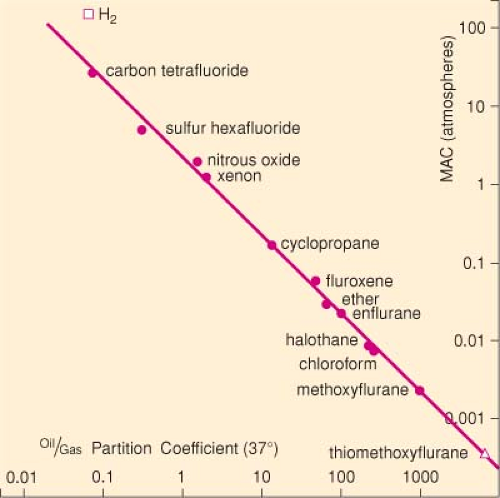Mechanisms of Anesthesia and Consciousness
The introduction of general anesthetics into clinical practice more than 150 years ago stands as one of the seminal innovations of medicine. It facilitated the development of modern surgery and spawned the specialty of anesthesiology (Crowder CM, Palanca BJ, Evers AS. Mechanisms of anesthesia and consciousness. In: Barash PG, Cullen BF, Stoelting RK, Cahalan MK, Ortega R, Stock MC, eds. Clinical Anesthesia. Philadelphia: Lippincott Williams & Wilkins; 2013: 105–129). Despite the importance of general anesthetics and more than 100 years of active research, the molecular mechanisms responsible for anesthetic action remain one of the unsolved mysteries of science (Table 5-1).
I. What is Anesthesia?
A practical description of the anesthetic state is a collection of “component” changes in behavior or perception (components of the anesthetic state include unconsciousness, amnesia, analgesia, immobility, and attenuation of autonomic responses to noxious stimulation). Regardless of which definition of anesthesia is used, rapid and reversible drug-induced changes in behavior or perception are essential to anesthesia. As such, anesthesia can only be defined and measured in an intact organism.
It has long been assumed that anesthesia is a state that is achieved when an anesthetic agent reaches a specific concentration at its effect site in the brain and that if tolerance to the anesthetic develops, increasing concentrations of anesthetic might be required to maintain a constant level of anesthesia during prolonged anesthetic administration.
The recent finding that it takes a higher anesthetic brain concentration to induce anesthesia than to maintain anesthesia
(emergence occurs at a significantly lower concentration than induction) contradicts these assumptions. This phenomenon is referred to as neural inertia and suggests that the mechanisms of anesthetic induction and emergence may be different.
Table 5-1 Why Are Mechanisms of Anesthesia so Difficult to Elucidate? | |
|---|---|
|
II. How is Anesthesia Measured?
Quantitative measurements of anesthetic potency are essential to study the pharmacology of anesthetic action. The minimum alveolar concentration (MAC) is defined as the alveolar partial pressure of a gas at which 50% of humans do not respond to a surgical incision.
The use of MAC as a measure of anesthetic potency has the advantages that it is an extremely reproducible measurement that is remarkably constant over a wide range of species, and the use of the end-tidal gas concentration provides an index of the “free” concentration of drug required to produce anesthesia because the end-tidal gas concentration is in equilibrium with the free concentration in plasma.
The MAC concept has several important limitations, particularly when trying to relate MAC values to anesthetic potency observed in vitro (Table 5-2).
Monitors that measure some correlate of anesthetic depth have been introduced into clinical practice.
The most popular of these monitors converts spontaneous electroencephalogram waveforms into a single value that correlates with anesthetic depth for some general anesthetics.
Table 5-2 Limitations of the Minimum Alveolar Concentration (Mac) Concept | |
|---|---|
|
III. What is the Chemical Nature of Anesthetic Target Sites?
The Meyer-Overton Rule (Fig. 5-1)
Because a wide variety of structurally unrelated compounds obey the Meyer-Overton rule, it has been reasoned that all anesthetics are likely to act at the same molecular site (referred to as the unitary theory of anesthesia).
Because solubility in a specific solvent strongly correlates with anesthetic potency, the anesthetic target site was assumed to be hydrophobic in nature.
The octanol–water partition coefficient best correlates with anesthetic potency, suggesting that the anesthetic site is likely to be amphipathic, having both polar and nonpolar characteristics.
Exceptions to the Meyer-Overton Rule
Compounds exist that are structurally similar to halogenated anesthetic, barbiturates, and neurosteroids yet are convulsants rather than anesthetics.
In several homologous series of anesthetics, anesthetic potency increases with increasing chain length until a certain critical chain length is reached. Beyond this critical chain length, compounds are unable to produce anesthesia even at the highest attainable concentrations (cutoff effect).

Stay updated, free articles. Join our Telegram channel

Full access? Get Clinical Tree









